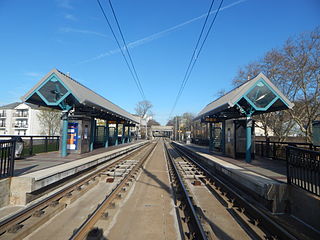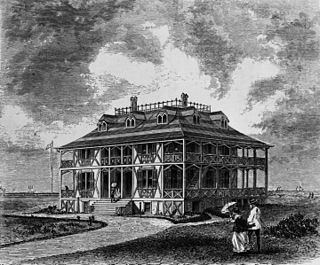
Long Branch is a beachside city in Monmouth County, New Jersey, United States. As of the 2010 United States Census, the city's population was 30,719, reflecting a decline of 621 (-2.0%) from the 31,340 counted in the 2000 Census, which had in turn increased by 2,682 (+9.4%) from the 28,658 counted in the 1990 Census. As of the 2010 census, it was the 6th-most-populous municipality in Monmouth County and had the 71st-highest population of any municipality in New Jersey.
The BMT Brighton Line, also known as the Brighton Beach Line, is a rapid transit line in the B Division of the New York City Subway in Brooklyn, New York City, United States. Local service is provided at all times by the Q train, but is joined by the B express train on weekdays. The Q train runs the length of the entire line from Coney Island–Stillwell Avenue to the Manhattan Bridge south tracks. The B begins at Brighton Beach and runs via the bridge's north tracks.

The Green Line is a rapid transit line on the Chicago Transit Authority's "L" system. It is the only completely elevated route in the entire system; all other routes either have underground sections or sections at grade. It utilizes the system's oldest segments, extending 20.695 miles (33.305 km) with 30 stops between Oak Park (Harlem/Lake) and Chicago's West Side, to the Loop, and then to the South Side and West Englewood (Ashland/63rd) and Woodlawn. As of 2019, an average of 38,755 passengers board each weekday.

The Bergen County Line is a commuter rail line and service owned and operated by New Jersey Transit in the U.S. state of New Jersey. The line loops off the Main Line between the Meadowlands and Glen Rock, with trains continuing in either direction along the Main Line. It is colored on NJT system maps in grey, and its symbol is a cattail, which are commonly found in the Meadowlands where the line runs.
The Northern Branch is a railroad line that runs from Jersey City to Northvale in northeastern New Jersey. The line was constructed in 1859 by the Northern Railroad of New Jersey to connect the New York and Erie Railroad's Piermont Branch terminus in Piermont, New York, to Erie's Pavonia Terminal in Jersey City. The line was then extended to Nyack, New York in 1870 and provided passenger service until 1966. Ownership of the line passed into the hands of Conrail upon the its formation in 1976.

The Millstone and New Brunswick Railroad (M&NB) was chartered in the mid-19th century as a seven-mile long branch line from New Brunswick, New Jersey to East Millstone, New Jersey. Construction was completed and the line began operation on December 19, 1854. In 1871, under the order of the company's president Martin Howell, the M&NB signed a 999-year lease with the United Jersey Railroad Company, which would later become part of the Pennsylvania Railroad (PRR) known as the "Millstone Branch." In 1915, the company was dissolved and became part of the United Jersey Railroad Company.

Garfield Avenue is a station on the Hudson–Bergen Light Rail (HBLR) in the Claremont section of Jersey City, Hudson County, New Jersey. Located between the grade crossing at Randolph Avenue and the bridge at Garfield Avenue, the station in a double side platform and two track structure. The station is on the West Side Avenue branch of the Hudson–Bergen Light Rail, which goes from West Side Avenue station to Tonnelle Avenue station in North Bergen. The station is accessible for handicapped people as per the Americans with Disabilities Act of 1990. An elevator is present to get people from Garfield Avenue to track level and the platforms are even with the train cars. The station opened to the public on April 17, 2000 as part of the original operating segment of the Hudson–Bergen Light Rail.

The Far Rockaway Branch is an electrified rail line and service owned and operated by the Long Island Rail Road in the U.S. state of New York. The branch begins at Valley Interlocking, just east of Valley Stream station. From Valley Stream, the line heads south and southwest through southwestern Nassau County, ending at Far Rockaway in Queens, thus reentering New York City. LIRR maps and schedules indicate that the Far Rockaway Branch service continues west along the Atlantic Branch to Jamaica. This two-track branch provides all day service in both directions to the Atlantic Terminal in Brooklyn, with limited weekday peak service to/from Penn Station in Midtown Manhattan. During peak hours, express service may bypass Jamaica station.

Nanuet is a train station in Nanuet, New York, serving Metro-North Railroad and NJ Transit trains on the Pascack Valley Line. Its official address is 1 Prospect Street, but in reality, it is located on Orchard Street West, diagonally off the southwest corner of Prospect Street and Middletown Road.

Patchogue is a station of the Montauk Branch of the Long Island Rail Road in the village of Patchogue, New York. It is on Division Street between West Avenue and South Ocean Avenue. This train station is located in the Patchogue-Medford Union Free School District.

Elberon is a railway station in the Elberon section of Long Branch, Monmouth County, New Jersey, United States. The station is served by New Jersey Transit's North Jersey Coast Line. Located at the intersection of Lincoln Avenue and Truax Road, It is the first station south of the electrified section of the line. The station has two side level high-level platforms and 229 parking spaces for commuter use.

Elberon is an unincorporated community that is part of Long Branch in Monmouth County, New Jersey, United States. The area is served as United States Postal Service ZIP code 07740.

The Church of the Presidents is a former Episcopal chapel on the Jersey Shore where seven United States presidents worshipped. It was visited by presidents Ulysses S. Grant, Rutherford B. Hayes, James A. Garfield, Chester A. Arthur, Benjamin Harrison, William McKinley, and Woodrow Wilson. All except Grant were in office when they paid their visits to the church.

James A. Garfield, the 20th president of the United States, was shot at the Baltimore and Potomac Railroad Station in Washington, D.C., at 9:30 am on Saturday, July 2, 1881. He died in Elberon, New Jersey, 79 days later on September 19, 1881. The shooting occurred less than four months into his term as president. Garfield's assassin was Charles J. Guiteau, whose motive was revenge against Garfield for an imagined political debt, and getting Chester A. Arthur elevated to president. Guiteau was convicted of Garfield's murder and executed by hanging one year after the shooting.

The Atlantic City Railroad was a Philadelphia and Reading Railway subsidiary that became part of Pennsylvania-Reading Seashore Lines in 1933. At the end of 1925 it operated 161 miles (259 km) of road on 318 miles (512 km) of track; that year it reported 43 million ton-miles of revenue freight and 204 million passenger-miles.
The Ocean Electric Railway was a street car line that operated on The Rockaways. It ran parallel to parts of the Rockaway Beach Branch and Far Rockaway Branch of the Long Island Rail Road. The headquarters of the OER were at the Far Rockaway Long Island Rail Road station which was then located across Mott Avenue from the existing Far Rockaway–Mott Avenue subway station. The Office of Superintendent - Trolleys at that location managed all the LIRR's owned trolley operations.
The Operating Passenger Railroad Stations Thematic Resource is a list of 53 New Jersey Transit stations in New Jersey entered into the New Jersey Register of Historic Places and National Register of Historic Places in 1984 for their architectural, historical, and cultural merit.
Charles Gilbert Francklyn was a British-American capitalist and industrialist who was prominent in New York society during the Gilded Age.

The Ulysses S. Grant Cottage was the Summer White House of U.S. President Ulysses S. Grant in Elberon, a part of Long Branch, New Jersey. Grant vacationed at the cottage starting in the summer of 1867, and thereafter spent three months of every summer there until 1885. He held cabinet meetings and composed parts of his memoirs at the cottage. The presence of Grant and the cottage helped popularize Elberon as a place for the elite to meet; a status that only faded when the railroad came to town and it became more accessible. The cottage was demolished in 1963 by its then owner, who did not possess the funds necessary to preserve the building. The site is today a grassy field.















